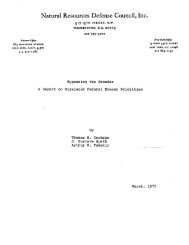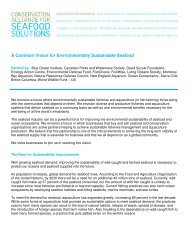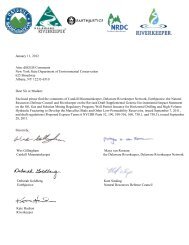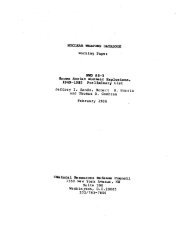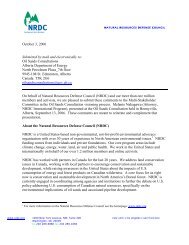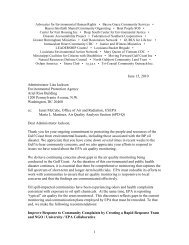3. Nuclear weapons - NRDC Document Bank - Natural Resources ...
3. Nuclear weapons - NRDC Document Bank - Natural Resources ...
3. Nuclear weapons - NRDC Document Bank - Natural Resources ...
Create successful ePaper yourself
Turn your PDF publications into a flip-book with our unique Google optimized e-Paper software.
agreed to in the SALT negotiations-any weapon that can be delivered from<br />
5500 km or more is considered 'strategic'. So the similar figure of 6000<br />
warheads on strategic systems covers very different systems according to which<br />
definition is used. The Soviet proposal would include all US systems potentially<br />
capable of striking the USSR: intercontinental-range ballistic missiles and<br />
bombers, aircraft and missiles of medium range or less in Europe and in Asia<br />
(within range of the USSR), and all nuclear-capable aircraft on aircraftcarriers.<br />
(The intermediate-range missiles on either side in Europe are dealt<br />
with in the separate proposal for their elimination. The fact that the USSR is<br />
engaged in separate INF negotiations with the USA calls into question how far<br />
it will push this wider definition of 'strategic'.) Unlike the US proposal,<br />
the USSR would also include gravity bombs and short-range attack<br />
missiles (SRAMs) in addition to the air-launched cruise missiles (ALCMs)<br />
carried on bombers, as well as sea-launched cruise missiles (SLCMs), which<br />
make up an increasingly important segment of the US arsenal.<br />
<strong>3.</strong> The US preoccupation with Soviet heavy ICBMs is seen in several facets of<br />
the US proposal: the ICBM warhead limit of 3000, the limit on throw-weight,<br />
and the ban on modernizing or replacing the SS-18. Since the Soviet SS-18 force<br />
could currently carry a maximum of 3080 warheads, the US proposal requires a<br />
cut in this force regardless of what mix of missiles the USSR might choose. The<br />
Soviet warhead limit of 3600 on anyone component of the strategic forces<br />
would permit all 308 SS-18s to remain only if the vast majority of its other<br />
ICBMs were scrapped. In any event, the Soviet offer would also bring down its<br />
own throw-weight to a level close to the US limit of about 3 million kg.<br />
4. The Soviet proposals continue to emphasize cruise missiles, calling for a<br />
ban on all such missiles except ALCMs with a range of 600 km or less. In this<br />
regard the USSR is either currently deploying or preparing to deploy several<br />
models of long-range cruise missiles, including ALCMs, SLCMs and GLCMs.<br />
The USA continues to exclude SLCMs from any of its proposals, although they<br />
can hardly be excluded from either the 'strategic' or 'intermediate-range'<br />
categories of weapon.<br />
5. Congress generally supported the idea, following the 1983 Scowcroft<br />
Commission suggestion, that both superpowers should move from MIRVed,<br />
stationary ICBMs to mobile, single-warhead systems such as the US small<br />
ICBM (Midgetman). However, in a surprising policy shift the USA now<br />
proposes to ban all mobile ICBMs (including the Soviet SS-24 and SS-25, and<br />
any mobile versions of the US MX or SICBM), presumably because they are<br />
harder than fixed ICBMs to locate and destroy, or to defend against with a<br />
strategic defence system.<br />
6. The United States argues that there is no way in which constraints on<br />
strategic defence research can be embodied in a treaty, and that in any case the<br />
Soviet Union is also heavily engaged in research on BMO systems-research<br />
which (unlike the United States) it does not disclose. Further, the United<br />
States points out that it has (for the time being) decided to keep SOl within the<br />
'restrictive' interpretation of the ABM Treaty. However, it will certainly<br />
continue to argue that the eventual development of defensive systems is a<br />
sensible concomitant of a reduction of offensive systems.



